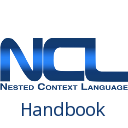EDTV/BDTV Profile Introduction
What is the NCL 3.0 EDTV/BDTV Profile?
EDTV is the acronym for Enhanced Digital TV.
The NCL 3.0 Enhanced DTV (EDTV) profile is the standard declarative language of the Japanese-Brazilian DTV middleware ISDB-TB for fixed and mobile receivers, and also ITU-T Recommendation for IPTV services.
BDTV is the acronym for Basic Digital TV.
The NCL 3.0 Basic DTV (BDTV) profile is a simplification of the EDTV profile in which transition effects and metadata functionalities are optional. This profile is the standard declarative language of the Japanese-Brazilian DTV middleware ISDB-TB for portable receivers.
The following processing instruction must be written in an NCL document in conformance with these profiles.
<?xml version="1.0"?> <ncl id="any string" xmlns="http://www.ncl.org.br/NCL3.0/profileName">
The profileName, in the URI path, identifies the language profile used to specify the document and must be, in this case, EDTVProfile or BDTVProfile, respectively.
Fourteen functionality areas with twenty nine modules are used to define the Enhanced DTV and the Basic DTV profiles. Attributes and contents (child elements) of each element of a module may be defined in the module itself or in the language profile that groups the modules.
In this handbook, each language element is presented in a specific section. Each of these sections contains a one line element table in which element's required attributes are underlined. In these tables, the following symbols are used: (?) optional (zero or one occurrences), (|) or, (*) zero or more occurrences, (+) one or more occurrences. The value of an attribute may not contain quotation marks ("). When a value is a string, it must begin with a letter or an underscore and must contain only letters, digits, “.” and “_”.
